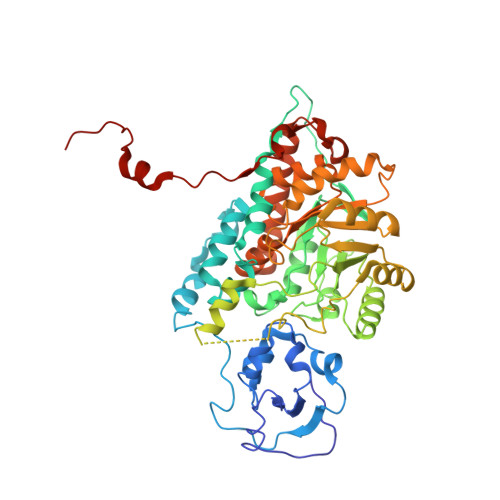Mechanistic and structural studies of H373Q flavocytochrome b2: effects of mutating the active site base.
Tsai, C.L., Gokulan, K., Sobrado, P., Sacchettini, J.C., Fitzpatrick, P.F.(2007) Biochemistry 46: 7844-7851
- PubMed: 17563122
- DOI: https://doi.org/10.1021/bi7005543
- Primary Citation of Related Structures:
2OZ0 - PubMed Abstract:
His373 in flavocytochrome b2 has been proposed to act as an active site base during the oxidation of lactate to pyruvate, most likely by removing the lactate hydroxyl proton. The effects of mutating this residue to glutamine have been determined to provide further insight into its role. The kcat and kcat/Klactate values for the mutant protein are 3 to 4 orders of magnitude smaller than the wild-type values, consistent with a critical role for His373. Similar effects are seen when the mutation is incorporated into the isolated flavin domain of the enzyme, narrowing the effects to lactate oxidation rather than subsequent electron transfers. The decrease of 3500-fold in the rate constant for reduction of the enzyme-bound FMN by lactate confirms this part of the reaction as that most effected by the mutation. The primary deuterium and solvent kinetic isotope effects for the mutant enzyme are significantly smaller than the wild-type values, establishing that bond cleavage steps are less rate-limiting in H373Q flavocytochrome b2 than in the wild-type enzyme. The structure of the mutant enzyme with pyruvate bound, determined at 2.8 A, provides a rationale for these effects. The orientation of pyruvate in the active site is altered from that seen in the wild-type enzyme. In addition, the active site residues Arg289, Asp 292, and Leu 286 have altered positions in the mutant protein. The combination of an altered active site and the small kinetic isotope effects is consistent with the slowest step in turnover being a conformational change involving a conformation in which lactate is bound unproductively.
Organizational Affiliation:
Department of Chemistry, Texas A&M University, College Station, Texas 77843-2128, USA.

















